golang:协程安全
多路复用
Go语言中提供了一个关键字select,通过select可以监听channel上的数据流动。select的用法与switch语法类似,由select开始一个新的选择块,每个选择条件由case语句来描述。只不过,select的case有比较多的限制,其中最大的一条限制就是每个case语句里必须是一个IO操作。
select 语法如下:
select {
case <-chan1:
// 如果chan1成功读到数据,则进行该case处理语句
case chan2 <- 1:
// 如果成功向chan2写入数据,则进行该case处理语句
default:
// 如果上面都没有成功,则进入default处理流程
}
在一个select语句中,会按顺序从头至尾评估每一个发送和接收的语句;如果其中的任意一语句可以继续执行(即没有被阻塞),那么就从那些可以执行的语句中任意选择一条来使用。如果没有任意一条语句可以执行(即所有的通道都被阻塞),那么有两种可能的情况:⑴ 如果给出了default语句,那么就会执行default语句,同时程序的执行会从select语句后的语句中恢复。⑵ 如果没有default语句,那么select语句将被阻塞,直到至少有一个channel可以进行下去。
在一般的业务场景下,select不会用default,当监听的流中再没有数据,IO操作就 会阻塞现象,如果使用了default,此时可以出让CPU时间片。如果使用了default 就形成了非阻塞状态,形成了忙轮训,会占用CPU、系统资源。
阻塞与非阻塞使用场景
- 阻塞: 如:在监听超时退出时,如果100秒内无操作,择退出,此时添加了default会形成忙轮训,超时监听变成了无效。
- 非阻塞: 如,在一个只有一个业务逻辑处理时,主进程控制进程的退出。此时可以使用default。
定时器
Go语言中定时器的使用有三个方法
time.Sleep()time.NewTimer()返回一个时间的管道, time.C 读取管道的内容time.After(5 * time.Second)封装了time.NewTimer(),反回了一个time.C的管道
示例
select {
case <-time.After(time.Second * 10):
}
锁和条件变量
Go语言中为了解决协程间同步问题,提供了标准库代码,包sync和sync/atomic中。
互斥锁
互斥锁是传统并发编程对共享资源进行访问控制的主要手段,它由标准库sync中的Mutex结构体类型表示。sync.Mutex类型只有两个公开的指针方法,Lock和Unlock。Lock锁定当前的共享资源,Unlock进行解锁。
package main
import (
"fmt"
"runtime"
"sync"
"time"
)
var mutex sync.Mutex
func print(str string) {
mutex.Lock() // 添加互斥锁
defer mutex.Unlock() // 使用结束时解锁
for _, data := range str { // 迭代器
fmt.Printf("%c", data)
time.Sleep(time.Second) // 放大协程竞争效果
}
fmt.Println()
}
func main() {
go print("hello") // main 中传参
go print("world")
for {
runtime.GC()
}
}

读写锁
读写锁的使用场景一般为读多写少,可以让多个读操作并发,同时读取,但是对于写操作是完全互斥的。也就是说,当一个goroutine进行写操作的时候,其他goroutine不能进行读写操作;当一个goroutine获取读锁之后,其他的goroutine获取写锁都会等待
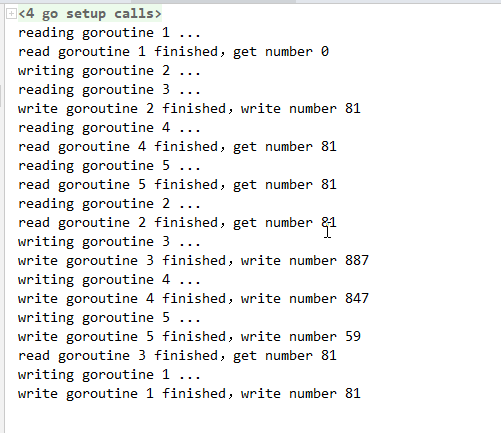
package main
import (
"fmt"
"math/rand"
"sync"
"time"
)
var count int // 全局变量count
var rwlock sync.RWMutex // 全局读写锁 rwlock
func read(n int) {
for {
rwlock.RLock()
fmt.Printf("reading goroutine %d ...\n", n)
num := count
fmt.Printf("read goroutine %d finished,get number %d\n", n, num)
rwlock.RUnlock()
}
}
func write(n int) {
for {
rwlock.Lock()
fmt.Printf("writing goroutine %d ...\n", n)
num := rand.Intn(1000)
count = num
fmt.Printf("write goroutine %d finished,write number %d\n", n, num)
rwlock.Unlock()
}
}
func main() {
for i := 0; i < 5; i++ {
go read(i + 1)
time.Sleep(time.Microsecond * 100)
}
for i := 0; i < 5; i++ {
go write(i + 1)
time.Sleep(time.Microsecond * 100)
}
for {
}
}
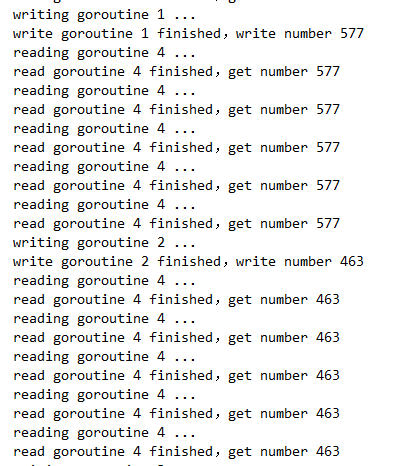
可以看出,读写锁控制下的多个写操作之间都是互斥的,并且写操作与读操作之间也都是互斥的。但是,多个读操作之间不存在互斥关系。
Go语言中的死锁
死锁 deadlock 是指两个或两个以上的进程在执行过程中,由于竞争资源或者由于彼此通信而造成的一种阻塞的现象,若无外力作用,它们都将无法推进下去。此时称系统处于死锁状态或系统产生了死锁。
单gorutine同时读写,写死锁
在一个gorutine中,当channel无缓冲,写阻塞,等待读取导致死锁
解决,应该至少在2个gorutine进行channle通讯,或者使用缓冲区。
package main
func main() {
channel := make(chan int)
channel <- 1
<-channel
}
多gorutine使用一个channel通信,写先于读
代码顺序执行时,写操作阻塞,导致后面协程无法启动进行读操作,导致死锁
package main
func main() {
channel := make(chan int)
channel <- 1
go func() {
<-channel
}()
}

多channel交叉死锁
在goroutine中,多个goroutine使用多个channel互相等待对方写入,导致死锁
package main
func main() {
channel1 := make(chan int)
channel2 := make(chan int)
go func() {
select {
case <-channel1:
channel2 <- 1
}
}()
select {
case <-channel2:
channel1 <- 1
}
}
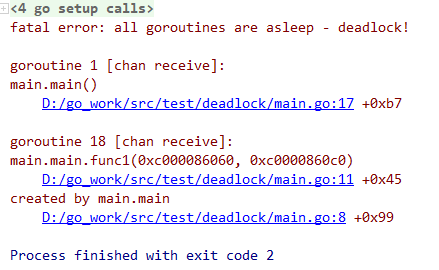
隐性死锁
尽量不要将 互斥锁、读写锁 与 channel 混用情况下,让读先进行读时,因为没写入被阻塞,无法解除。写入时,因为没有读出被阻塞,锁无法解除,导致无数据输出,形成隐形死锁。此时编译器是不报错的。

package main
import (
"fmt"
"sync"
)
func main() {
channel := make(chan int)
var rwlock sync.RWMutex
go func() {
for {
rwlock.Lock()
channel <- 1
fmt.Println("write", 1)
rwlock.Unlock()
}
}()
go func() {
for {
rwlock.RLock()
n := <-channel
fmt.Println(n)
rwlock.Unlock()
}
}()
for {
}
}
Context 上下文
context定义了上下文类型,该类型在API边界之间以及进程之间传递截止时间,取消信号和其他请求范围的值。当在对请求传入一个上下文,可以选择将其替换为使用WithCancel,WithDeadline,WithTimeout。在取消后,从该context处派生的所有子请求也会被取消。
Context的结构体
- Deadline() 返回context的截止时间。
- Done() 返回一个channle,当timeout或cancelfuc将会close(chan)
- Err() 返回错误,未关闭Done()返回nil,取消,返回
"context canceled", Deadline返回超时 - Value 返回值。
type Context interface {
// Deadline returns the time when work done on behalf of this context
// should be canceled. Deadline returns ok==false when no deadline is
// set. Successive calls to Deadline return the same results.
Deadline() (deadline time.Time, ok bool)
// Done returns a channel that's closed when work done on behalf of this
// context should be canceled. Done may return nil if this context can
// never be canceled. Successive calls to Done return the same value.
// The close of the Done channel may happen asynchronously,
// after the cancel function returns.
//
// WithCancel arranges for Done to be closed when cancel is called;
// WithDeadline arranges for Done to be closed when the deadline
// expires; WithTimeout arranges for Done to be closed when the timeout
// elapses.
//
// Done is provided for use in select statements:
//
// // Stream generates values with DoSomething and sends them to out
// // until DoSomething returns an error or ctx.Done is closed.
// func Stream(ctx context.Context, out chan<- Value) error {
// for {
// v, err := DoSomething(ctx)
// if err != nil {
// return err
// }
// select {
// case <-ctx.Done():
// return ctx.Err()
// case out <- v:
// }
// }
// }
//
// See https://blog.golang.org/pipelines for more examples of how to use
// a Done channel for cancellation.
Done() <-chan struct{}
// If Done is not yet closed, Err returns nil.
// If Done is closed, Err returns a non-nil error explaining why:
// Canceled if the context was canceled
// or DeadlineExceeded if the context's deadline passed.
// After Err returns a non-nil error, successive calls to Err return the same error.
Err() error
// Value returns the value associated with this context for key, or nil
// if no value is associated with key. Successive calls to Value with
// the same key returns the same result.
//
// Use context values only for request-scoped data that transits
// processes and API boundaries, not for passing optional parameters to
// functions.
//
// A key identifies a specific value in a Context. Functions that wish
// to store values in Context typically allocate a key in a global
// variable then use that key as the argument to context.WithValue and
// Context.Value. A key can be any type that supports equality;
// packages should define keys as an unexported type to avoid
// collisions.
//
// Packages that define a Context key should provide type-safe accessors
// for the values stored using that key:
//
// // Package user defines a User type that's stored in Contexts.
// package user
//
// import "context"
//
// // User is the type of value stored in the Contexts.
// type User struct {...}
//
// // key is an unexported type for keys defined in this package.
// // This prevents collisions with keys defined in other packages.
// type key int
//
// // userKey is the key for user.User values in Contexts. It is
// // unexported; clients use user.NewContext and user.FromContext
// // instead of using this key directly.
// var userKey key
//
// // NewContext returns a new Context that carries value u.
// func NewContext(ctx context.Context, u *User) context.Context {
// return context.WithValue(ctx, userKey, u)
// }
//
// // FromContext returns the User value stored in ctx, if any.
// func FromContext(ctx context.Context) (*User, bool) {
// u, ok := ctx.Value(userKey).(*User)
// return u, ok
// }
Value(key interface{}) interface{}
}
演示使用可取消的上下文。可在函数结束时defer cancel() 防止goroutine的泄露。
package main
import (
"context"
"fmt"
"time"
)
func worker(ctx context.Context, name string) {
n := 0
for {
select {
case <-ctx.Done():
fmt.Println(name, "去划水了", n)
return
default:
fmt.Println(name, "干活中", n)
time.Sleep(time.Second)
}
n++
}
}
func main() {
ctx, cancel := context.WithCancel(context.Background())
for n := 0; n < 5; n++ {
go worker(ctx, fmt.Sprintf("worker%d", n))
}
<-time.After(time.Second * 5)
cancel()
for {
}
}

超时处理,WithTimeout 当时间到达设置的时间后退出,也可以使用cancelFunc()退出处理
package main
import (
"context"
"fmt"
"time"
)
func worker(ctx context.Context, name string) {
n := 0
for {
select {
case <-ctx.Done():
fmt.Println(name, "去划水了", n)
return
default:
fmt.Println(name, "干活中", n)
time.Sleep(time.Second)
}
n++
}
}
func main() {
//ctx, cancel := context.WithCancel(context.Background())
ctx, cancel := context.WithTimeout(context.Background(), 3*time.Second)
for n := 0; n < 2; n++ {
go worker(ctx, fmt.Sprintf("worker%d", n))
}
<-time.After(time.Second * 5)
fmt.Println("取消了")
cancel()
}
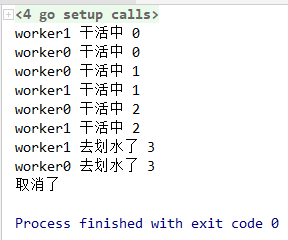
WithDeadline,在标准库中可以看出,实际上WithTimeout是封装了WithDeadline。其功能也是超时退出。

package main
import (
"context"
"fmt"
"time"
)
func worker(ctx context.Context, name string) {
n := 0
for {
select {
case <-ctx.Done():
fmt.Println(name, "去划水了", n)
fmt.Println(ctx.Err())
return
default:
fmt.Println(name, "干活中", n)
time.Sleep(time.Second)
}
n++
}
}
func main() {
ctx, cancel := context.WithDeadline(context.Background(), time.Now().Add(time.Second*3))
for n := 0; n < 2; n++ {
go worker(ctx, fmt.Sprintf("worker%d", n))
}
<-time.After(time.Second * 5)
fmt.Println("取消了")
cancel()
}
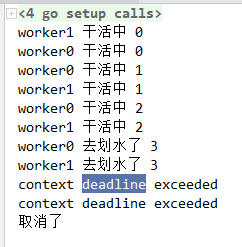
Context总结
- Context是Go语言在1.7中加入标准库的,是作为
Goroutine线程安全,防止线程泄露的上下文管理的操作。 - context包的核心是
Context结构体。 - Context的常用方法为
WithTimeout()与WithCancel() - Context在使用时,不要放在结构体内使用,要以函数的参数进行传递。
- Context是线程安全的,可以在多个
Goroutine传递,当对其取消操作时,所有Goroutine都执行取消操作。
golang:协程安全的更多相关文章
- golang协程同步的几种方法
目录 golang协程同步的几种方法 协程概念简要理解 为什么要做同步 协程的几种同步方法 Mutex channel WaitGroup golang协程同步的几种方法 本文简要介绍下go中协程的几 ...
- Python与Golang协程异同
背景知识 这里先给出一些常用的知识点简要说明,以便理解后面的文章内容. 进程的定义: 进程,是计算机中已运行程序的实体.程序本身只是指令.数据及其组织形式的描述,进程才是程序的真正运行实例. 线程的定 ...
- 面试必问:Golang高阶-Golang协程实现原理
引言 实现并发编程有进程,线程,IO多路复用的方式.(并发和并行我们这里不区分,如果CPU是多核的,可能在多个核同时进行,我们叫并行,如果是单核,需要排队切换,我们叫并发) 进程和线程的区别 进程是计 ...
- Golang协程实现流量统计系统(3)
进程.线程.协程 - 进程:太重 - 线程:上下文切换开销太大 - 协程:轻量级的线程,简洁的并发模式 Golang协程:goroutine Hello world package main impo ...
- golang协程池设计
Why Pool go自从出生就身带“高并发”的标签,其并发编程就是由groutine实现的,因其消耗资源低,性能高效,开发成本低的特性而被广泛应用到各种场景,例如服务端开发中使用的HTTP服务,在g ...
- Golang 协程调度
一.线程模型 N:1模型,N个用户空间线程在1个内核空间线程上运行.优势是上下文切换非常快但是无法利用多核系统的优点. 1:1模型,1个内核空间线程运行一个用户空间线程.这种充分利用了多核系统的优势但 ...
- golang 协程嵌套,会产生依赖关系(父子关系)么?
编码时冒出一个问题:在一个协程内部,再创建一个或多个协程,是否会产生依赖关系? 做了一个小实验,这里随笔记录一下经过,备注后续深入研究. test代码: package main import ( & ...
- Golang协程与通道整理
协程goroutine 不由OS调度,而是用户层自行释放CPU,从而在执行体之间切换.Go在底层进行协助实现 涉及系统调用的地方由Go标准库协助释放CPU 总之,不通 ...
- 关于协程:nodejs和golang协程的不同
nodejs和golang都是支持协程的,从表现上来看,nodejs对于协程的支持在于async/await,golang对协程的支持在于goroutine.关于协程的话题,简单来说,可以看作是非抢占 ...
- golang协程——通道channel阻塞
新的一年开始了,不管今天以前发生了什么,向前看,就够了. 说到channel,就一定要说一说线程了.任何实际项目,无论大小,并发是必然存在的.并发的存在,就涉及到线程通信.在当下的开发语言中,线程通讯 ...
随机推荐
- SFDC 利用Schema.Describe来取得Picklist所有的选项
Salesforce的开发语言Apex与Java极为类似.也有封装,基础,多态特性. 并且也能 反射,Object的属性和Field属性. 今天主要记录的是一个需求:Visualforce Page或 ...
- BST(二叉搜索树)的基本操作
BST(二叉搜索树) 首先,我们定义树的数据结构如下: public class TreeNode { int val; TreeNode left; TreeNode right; public T ...
- OO第四单元总结 and 学期总结
第四次单元总结 本单元架构设计总结 第一次作业:类图解析 本次作业仅仅需要实现官方的UmlInteraction接口,通过反射机制在Runner中实例化一个我们实现的类,来进行类图元素的分类解析,从而 ...
- 因为这几个TypeScript代码的坏习惯,同事被罚了500块
作者:Daniel Bartholomae 翻译:疯狂的技术宅 原文链接:https://startup-cto.net/10-bad-typescript-habits-to-break-this- ...
- django-数据库的增删改查操作
django-数据库的增删改查操作 1.添加用户记录 def login(request): 增加用户记录 使用save()方法来增加记录 username = UserInfo(username=' ...
- 基于sinc的音频重采样(二):实现
上篇(基于sinc的音频重采样(一):原理)讲了基于sinc方法的重采样原理,并给出了数学表达式,如下: (1) 本文讲如何基于这个数学表达式来做软件实现.软件实现的 ...
- 死磕Spring之AOP篇 - Spring AOP自动代理(二)筛选合适的通知器
该系列文章是本人在学习 Spring 的过程中总结下来的,里面涉及到相关源码,可能对读者不太友好,请结合我的源码注释 Spring 源码分析 GitHub 地址 进行阅读. Spring 版本:5.1 ...
- IDEA/JRebel实现内部/外部/远程Tomcat热部署Spring Boot
1 概述 所谓热部署,对于Java应用程序来说,就是在运行时更新Java类文件.IDEA可以使用自带的Spring Boot热部署的方式进行本地/远程热部署,或者使用JRebel进行本地/远程热部署, ...
- GO-03-基础
可见性 Go语言中,使用大小写来决定标识符(常量.变量.类型.接口.结构或函数)是否可以被外部包所调用. 大写字母开头,那么其对象就可以被外部包的代码所使用,如同public. 小写字母开头,则对包外 ...
- 2021年IT行业八大趋势预测
在新冠疫情的影响下,过去一年的IT行业产生着或多或少的变化.而今,2020年已走过一个季度,本文根据国内外一些调研机构的数据,整合了以下八条更适合国内的2021年IT行业趋势分析,希望能为相关决策者提 ...
